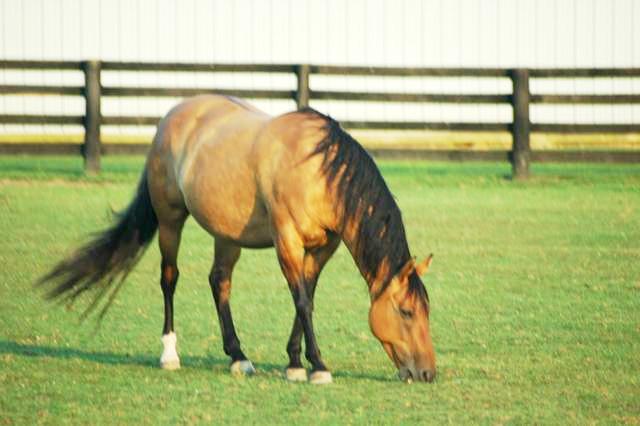by Cowgirl on October 13, 2011
I finally got a chance to test drive the new horse last night. We have been in the process of building new pens for our feeder calves through the summer, and all of the portable panels for my round pen were being used to complete the half-finished pen. So last weekend we finished up that project, which allowed me to set up my round pen and try riding the new buckskin mare for the first time. I was anxious to see if our craigslist purchase was a good find or a big mistake.
I always enjoy reading horse training articles and stories about amazing horsemen. I am always inspired by the things they have learned from the thousands of horses they’ve handled, and thrilled when they share their knowledge with us. Here are some horse quotes from some of the best horse trainers in the world.
I have always been a non-confrontational person. And believe it or not, it carries over to how I deal with horses, too. It’s not that horses scare me or that I’m afraid to push my luck or take chances around them. I grew up with horses and I’ve never been seriously hurt by a horse, so I’ve never had any fear to overcome. But I have seen horses get hurt in bad situations, and spent subsequent years thinking of what I could have done differently that might have prevented their injury, and it makes me cautious and more respectful when handling them.
by Cowgirl on June 3, 2011
I was at my folks’ house last weekend, and was looking through some boxes of old photos, and came upon a letter I had written them many years ago when I was a lonely school teacher just out of college, with only horses to keep me from feeling homesick. Reading through it gave me a mix of feelings—happy to remember the fun day on horseback, sad to think that I ended up buying and losing this mare in a horrible accident, and very glad that I had written it all down in a letter so I could treasure the memories more completely.
Writing in response to a recent question from a reader of my horse blog, I’d like to address the issue of how to correct a horse that bites you when you’re handling it. In this day and age of political correctness, what kind of discipline is acceptable to train a horse to not bite?
by Cowgirl on February 16, 2011
Training a horse can be really hard and really easy. It depends on how well you can communicate to the horse and how well you can read what the horse is thinking. If you can recognize the moment in which the horse is trying to work for you and reward him for it, it creates a trust and a learning progression that will develop a strong foundation in the horse’s training.
Whether you’re paying someone to train your horse, give you lessons, or simply choosing which trainer to watch and follow on RFDtv, it’s important to understand what you’re learning and make an educated choice concerning trainers.
I had a reader contact me through my blog awhile back. She said that she and her family had acquired two yearling horses, and were having a little trouble getting them gentled down. These are just a few ideas to help you work through the first steps of gentling and training your horse.
I’m a little baffled today. We brought a couple new horses home to train over the weekend, and last night was the first chance I got to work with Toby. He’s a solid Paint, nine year old gelding, supposedly greenbroke but too nervous and wild for my brother to ride, so he sent him to my place for some training.
There’s one in every bunch. The horse that keeps his eye on you and no matter what enticement you offer from your pocket, he won’t let you catch him. Is there a cure for the horse that is hard to catch? Well, here are a few tips that might eliminate some wasted time and frustration when you’re trying to catch your horse.
by Cowgirl on September 9, 2010
If you are around horse people for any length of time, you are going to meet with strong personalities who are assured they are correct, to the point of everyone else being wrong. I would admit that I have been there….but I think I’ve arrived at the realization that I can never know enough, there is always more to learn, and anyone who will share their viewpoint with me is someone I can gain knowledge from.
by Cowgirl on August 21, 2010
I started out to the barn last night with a goal in mind. With my sorrel mare, Daisy, there are a few improvements to be made. I would like her to be lighter, more responsive, have a better headset, and develop a strong topline. After asking the advice of a few horse friends, as well as reading up on some training articles, the conclusion I arrived at was that we needed to start with flexion.
by Cowgirl on August 20, 2010
A reader of my blog contacted me the other day, asking for my advice with a problem she is having with her horse. She wrote that her high-headed well-broke gelding has developed a couple of issues since she started working on collection and lowering his head.
by Cowgirl on July 30, 2010
A lot of horses have trouble standing still for a rider to get into the saddle. For most of them, the real problem is that they have never been taught to stand. Some horses never develop the problem, but if your horse is one that just won’t wait for you to mount up, here are some things you can do to remedy this bad habit.
by Cowgirl on July 21, 2010
The previous groundwork exercises will give your horse a good understanding of how he should behave under saddle, and the ground driving will establish a habit of giving to rein pressure and being controlled by the rider. So all that’s left is to climb on the horse, but there are still a few precautions to take and things to work through to make sure the horse is ready to accept a person in the saddle.
by Cowgirl on July 21, 2010
Ground driving is an important step in preparing a young horse for being ridden, as it asks him to focus on the rider’s commands, yield to direct rein pressure, and covers the beginning basics of reining so that the first actual ride can be a much safer one.
by Cowgirl on July 16, 2010
I have climbed on colts bareback with no headgear for their “first ride”. But I think I was lucky to not get into trouble with that. I have also ridden colts in a round pen with no headgear, while another trainer worked the colt from horseback, directing and turning the colt in the round pen. But if it’s just you working with the colt, my suggestion is to introduce the bit and work on him bending his head a little before you ride.
by Cowgirl on July 15, 2010
Putting the first ride on a colt is an amazing thing to experience. Much forethought and preparation will make it more successful, because there is a bit more to training horses than climbing into the saddle and hanging on. I would like to share some tips for getting that first ride to be a good one. Always keep in mind that every horse is an individual, and will have certain needs and weaknesses that need to be worked on.
by Cowgirl on July 13, 2010
Some readers really need a firm grasp of the basics before they are able to work with a horse, so I’d like to explain how to go about putting the bridle on a horse. This is how a normal scenario of how bridling a horse should happen, but I would always remind you that every horse is different, each will react in its own way.
If you have ever worked with a colt on lunging, it can be one of the hardest concepts to teach, especially if the colt is a gentle, in-your-pocket type of horse. If the horse is really “hooked” on you, it’s going to feel really contradictory to your gentling process to have to make him go away from you. What you do need to establish is a cue, and follow it up with bodily actions that are “sending” actions that tell your horse it’s time to lunge.

